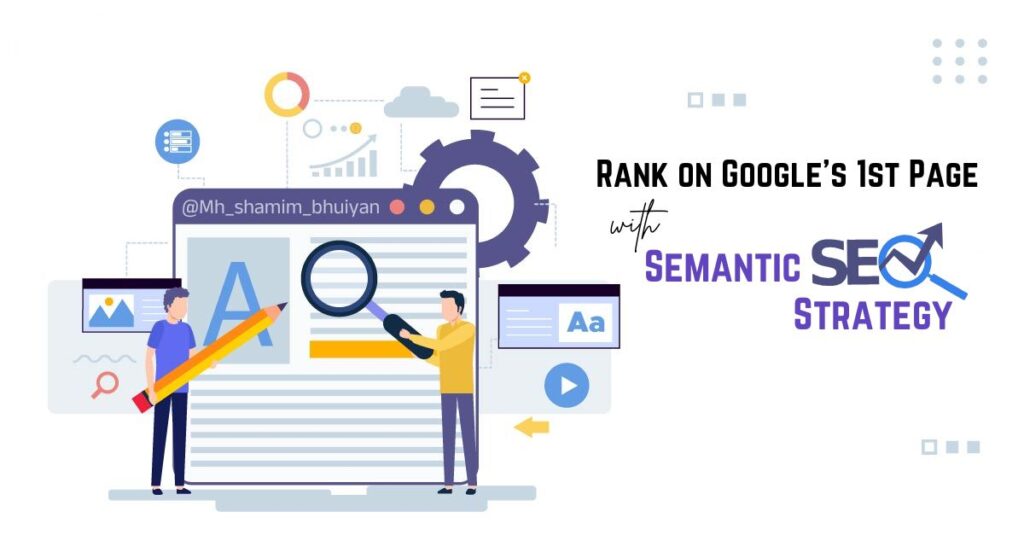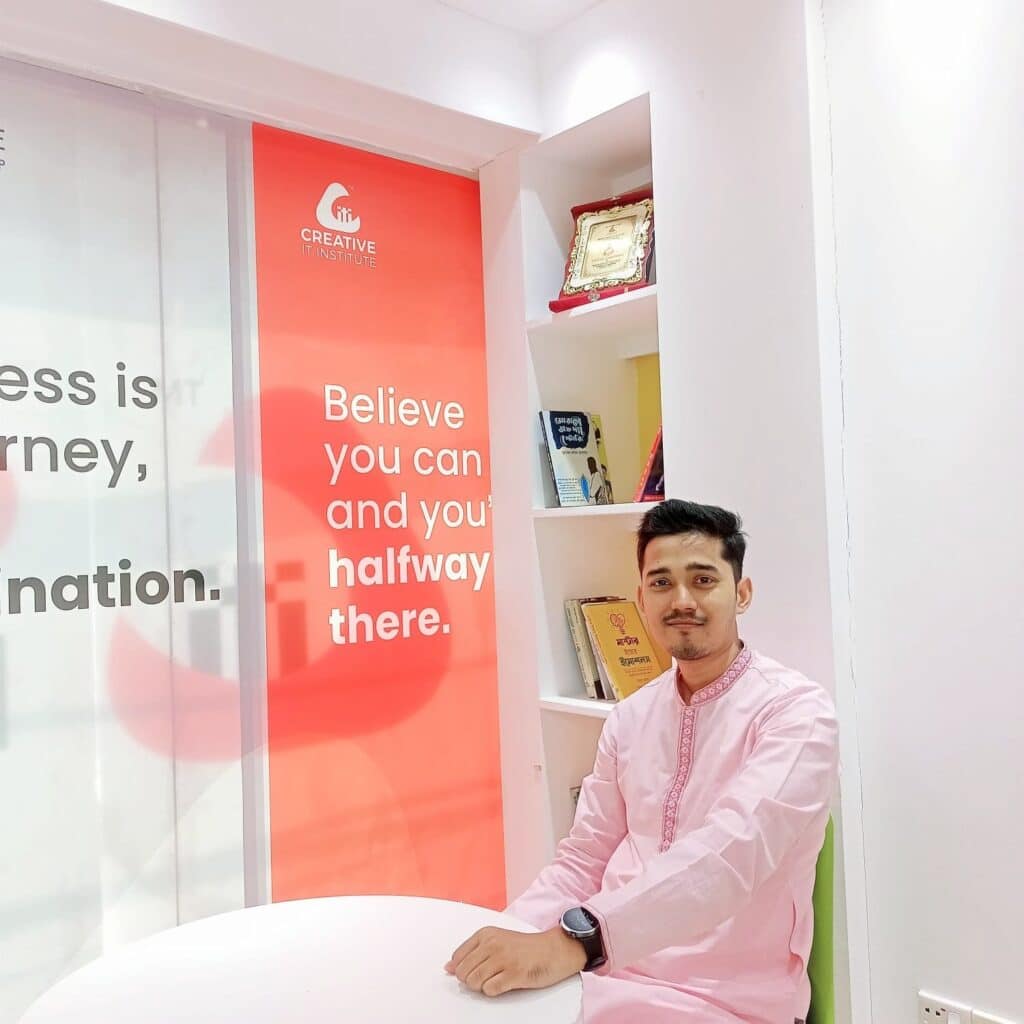
Struggling to get your website noticed in Bangladesh’s busy online world? If so, traditional SEO won’t cut it anymore. That’s why you need a semantic SEO strategy. It’s all about understanding the meaning behind search queries instead of just focusing on keywords.
With semantic SEO, you can create content that truly matches what users are looking for. As a result, search engines like Google can better understand your website. This means you have a higher chance of ranking on the 1st page of search results.
In this article, we’ll break down semantic SEO in simple terms. More importantly, you’ll discover why it matters for businesses in Bangladesh. Plus, we’ll share easy steps to help you create a strategy that boosts your rankings.
A Semantic SEO strategy focuses on the meaning behind search queries. It looks at user intent and context. Instead of just using keywords, it makes content relevant and helpful. The goal is to answer what users are searching for.
Traditional SEO focused on keywords and backlinks. But search engines like Google have become smarter. They now use NLP to understand search intent, not just exact words.
For example, if someone searches for “best places to visit in Dhaka,” Google looks beyond the exact phrase. It also checks for related topics like top tourist spots, travel guides, and local attractions.
NLP helps search engines understand human language better. It allows Google to recognize synonyms, context, and long-tail keywords.
For example, if you search for “best restaurants near me in Chittagong,” Google knows you want dining options in Chittagong. It will show results based on location and user intent.
Semantic SEO helps search engines show better results. In turn, it makes content more useful for users. Since Google uses tools like NLP and BERT, understanding search intent is crucial. Therefore, if you want higher rankings and more engagement, a Semantic SEO expert can help. They will optimize your content to match Google’s smart algorithms.
SEO is changing fast. Google’s AI and machine learning make search smarter. So, old tricks like keyword stuffing and backlinks don’t work well anymore. Now, success comes from understanding user intent and context. Plus, your content must truly satisfy search queries. Semantic HTML helps search engines better understand your content, improving your chances of ranking higher.
Google updates its algorithms to improve search results. Two key updates show why semantic SEO matters:

Google BERT (Bidirectional Encoder Representations from Transformers)
BERT helps Google understand search queries better. For example, in the query “can you get medicine for a cold from the pharmacy,” BERT understands the meaning and provides accurate results. This makes semantic SEO crucial because content needs to match user intent.
Google RankBrain
RankBrain uses machine learning to analyze complex searches. It helps Google understand long-tail keywords and related concepts. This means businesses need to create meaningful content, not just focus on individual keywords.
Artificial Intelligence and Natural Language Processing (NLP) help search engines understand words better. Google can now process searches in multiple languages. This is great for businesses in Bangladesh. With semantic SEO strategy, local businesses can rank higher in both Bengali and English searches.
Users now search differently. They use longer queries, ask questions, and rely more on voice search.
Long-Tail Keywords & Voice Search
People use virtual assistants like Google Assistant, Siri, and Alexa to search by voice. Voice searches are natural and often in full sentences, like “Where can I find the best biryani in Dhaka?” Businesses need to optimize for such conversational searches.
Conversational Search
Google focuses on understanding meaning, not just matching keywords. Content should answer user questions naturally to rank higher.
When content matches user intent, people stay on the website longer. This means better engagement and fewer bounce rates. In Bangladesh, businesses can benefit by creating content that is useful for local users.
Good semantic SEO strategy also improves user experience (UX). When content is clear, well-structured, and informative, users find what they need quickly. This keeps them coming back and increases conversions.
Semantic SEO helps content show up in rich snippets, knowledge panels, and position zero (the top Google result). These features grab attention and bring more clicks. For example, a restaurant in Dhaka can use structured data. By optimizing for “best restaurants in Dhaka,” it can appear in local search results. This boosts traffic and increases the click-through rate (CTR).
SEO is shifting towards semantic search. Businesses in Bangladesh must adapt to stay ahead. Google’s AI updates change how search works. User behavior is also evolving. To rank higher, companies must focus on context and intent.

Bangladesh’s digital market is growing fast. To stay ahead, businesses must use semantic SEO. This strategy improves rankings and attracts the right audience. Moreover, it boosts customer engagement. Traditional SEO is less effective now. So, adapting to semantic SEO strategy is key to staying competitive. Need help with Semantic SEO or WordPress SEO? Contact Mh Shamim Bhuiyan, one of the best SEO Specialists in Chittagong, Bangladesh.
First, semantic SEO helps businesses rank higher in local searches. By using local keywords, businesses can show up in Google’s local pack. For example, a restaurant in Chittagong can target phrases like “Best seafood restaurant in Chittagong.”
Next, businesses need to match their content with what users are searching for. There are three types of search intent:
Additionally, many people search in both Bengali and English. To reach a wider audience, businesses should target both languages. For example, a Dhaka hotel can target “best hotels in Dhaka” and “বেস্ট হোটেল ঢাকা.”
Furthermore, semantic SEO benefits sectors like e-commerce, tourism, education, and hospitality. E-commerce sites should use long-tail keywords. Similarly, tourism businesses can target local spots like “best tourist spots in Cox’s Bazar.”
In addition to content, the user experience is important. Websites should provide clear, useful information like menu options and customer reviews. A fast, mobile-friendly site will rank higher.
Finally, semantic SEO offers long-term benefits. It reduces the need for paid ads by improving organic rankings. By focusing on quality content, websites can stay at the top for years.
In conclusion, semantic SEO helps Bangladeshi businesses rank higher. It also keeps them competitive in the growing digital market.

Semantic SEO is more than just using keywords. It’s about creating content that matches search intent and provides useful information. For businesses in Bangladesh, this means making content clear, relevant, and valuable. Here’s how you can do it.
Keyword research is still important, but it’s not just about finding words. You need to understand why people search for them.
Good content is the key to semantic SEO. It should answer questions, provide useful details, and be easy to read.
Many people in Bangladesh search in both Bengali and English. Optimizing for both languages helps reach a wider audience.
More people in Bangladesh use voice search and mobile phones. Your content should be easy to find on these platforms.
Backlinks are still important, but quality matters more than quantity.
To succeed in SEO, businesses in Bangladesh must focus on user intent. They should create useful content and optimize for local searches. These steps help improve rankings. They also attract more visitors and grow the business online.
Semantic SEO strategy can greatly improve your website’s ranking and user engagement. However, some mistakes can slow your progress. To get the best results, avoid these errors.
Many businesses still focus only on keywords instead of understanding search intent.
Why It’s a Problem: If you only use keywords without context, your content may not answer what users are looking for. As a result, your rankings can drop.
How to Fix It: Don’t just add keywords. Write content that fully answers user questions. For example, if targeting “best restaurants in Dhaka,” include details like food types, price ranges, and customer reviews. This makes your content more helpful.
Many businesses in Bangladesh target only English searches. However, many users search in Bengali too.
Why It’s a Problem: If your content is only in one language, you miss out on a large portion of local search traffic.
How to Fix It: Use both Bengali and English in your SEO strategy. For instance, a tourism website should include both “best places to visit in Bangladesh” and “বাংলাদেশ ভ্রমণ স্থান” to reach more users.
Structured data (schema markup) helps search engines understand your content better.
Why It’s a Problem: Without structured data, your content may not appear in rich snippets or knowledge panels. Consequently, you miss out on higher visibility.
How to Fix It: Use schema markup for local businesses, products, reviews, and articles. Additionally, tools like Google’s Structured Data Markup Helper can make this process easier.
Nowadays, many people in Bangladesh use voice assistants like Google Assistant and Siri to search.
Why It’s a Problem: Voice searches are longer and more conversational. If your content isn’t optimized for them, you could lose potential traffic.
How to Fix It: Answer common questions in a natural, conversational way. For example, instead of only using “restaurants in Dhaka,” also include “Where can I find affordable restaurants near me?”
Search engines now prefer in-depth, useful content over short and vague articles.
Why It’s a Problem: Short content may not fully answer user queries. Additionally, it often struggles to rank well.
How to Fix It: Write detailed content that covers every part of the topic. For example, if writing about “Digital Marketing for Bangladeshi Startups,” include sections on SEO, social media, PPC, and content marketing.

SEO is constantly changing. What works today may not work tomorrow.
Why It’s a Problem: If you don’t update your strategy, your rankings may drop over time.
How to Fix It: Regularly track your SEO performance using Google Analytics and Google Search Console. Moreover, update your content to match new trends and search behaviors.
Good SEO isn’t just about ranking high, it’s also about keeping visitors engaged on your site.
Why It’s a Problem: A slow or hard-to-navigate website can lead to high bounce rates. Eventually, this can hurt your rankings.
How to Fix It: Improve your website’s page speed, mobile-friendliness, and navigation. Above all, make sure users can find what they need quickly.
Avoid these mistakes to improve your SEO. Focus on user intent, local search, and quality content. SEO takes time. Keep optimizing and updating your strategy for the best results.
After applying semantic SEO strategy, it’s important to track your results. This helps you improve your strategy and get better rankings. Below are key ways to measure success.

Organic traffic shows how many visitors find your site through search engines. If your content is well-optimized, traffic should increase over time.
Why It Matters: More organic traffic means your content is relevant to users and easy to find. This often comes from targeting long-tail keywords and user intent.
How to Track It: Use Google Analytics to check your organic traffic. Look at specific pages to see which ones perform best. For example, if you optimized a blog post on “best SEO strategies in Bangladesh,” check if its traffic has increased.
Looking for long-term organic growth for your website? Get in touch with Mh Shamim Bhuiyan, one of the top Semantic SEO expert in Chittagong, Bangladesh.
Keyword ranking shows where your content appears in search results. With semantic SEO, you should track related and long-tail keywords, not just main keywords.
Why It Matters: If your content ranks for many related terms or appears in rich results, it means Google understands it well.
How to Track It: Use Google Search Console, SEMrush, or Ahrefs to monitor rankings. Focus on long-tail keywords and featured snippets.
CTR shows how many users click on your site after seeing it in search results. A higher CTR means your title and description attract users.
Why It Matters: If your site ranks well but has a low CTR, it may need better meta descriptions or titles.
How to Track It: Google Search Console shows your CTR. If you have many impressions but low clicks, update your meta tags and headlines.
Engagement metrics show how users interact with your content. Important metrics include bounce rate, session duration, and pages per session.
Why It Matters: If users stay longer and explore more pages, your content is valuable. High engagement improves your rankings.
How to Track It: Use Google Analytics to check bounce rate and session duration. If visitors leave too quickly, improve your content structure and readability.
Featured snippets, answer boxes, and knowledge panels give high visibility. These results often appear at the top of Google.
Why It Matters: If your content appears in rich results, it shows Google trusts your information. It also brings more traffic.
How to Track It: Use Google Search Console or tools like Ahrefs to see if your pages appear in snippets or other rich results.
Backlinks from other websites boost your SEO. But for semantic SEO, quality is more important than quantity.
Why It Matters: Links from trusted and relevant websites show search engines that your content is authoritative.
How to Track It: Use Ahrefs, SEMrush, or Moz to check your backlinks. Focus on getting links from high-authority sites in your industry.
Getting traffic is great, but conversions matter more. A conversion can be a sign-up, purchase, or contact form submission.
Why It Matters: If visitors don’t take action, your site may need better CTAs (call-to-action) or landing pages.
How to Track It: Use Google Analytics to measure conversions. Test different CTAs and page designs to improve results.
Measuring SEO success helps you stay ahead of competitors. First, track organic traffic, rankings, CTR, engagement, snippets, backlinks, and conversions. Then, adjust your strategy for better results. With regular monitoring, your semantic SEO efforts will bring long-term growth in Bangladesh’s digital space.
SEO is changing fast. Businesses in Bangladesh must follow new trends to stay ahead. Adapting to these changes will improve rankings and attract more visitors. Let’s explore key trends shaping the future of semantic SEO.
AI and machine learning are making search engines smarter. Google uses AI-driven algorithms like RankBrain and BERT to understand user intent and context better.
Why It Matters: AI helps search engines focus on meaning, not just keywords. This improves search accuracy and relevance.
How to Prepare:
More people are using voice search on smartphones and smart speakers. They ask questions in a natural way, making searches longer and more specific.
Why It Matters: Voice searches often contain full questions like, “How can I start a business in Bangladesh?” Google favors clear, direct answers.
How to Prepare:
People now search using images and videos. Google and Pinterest are improving visual search tools. Video content is already a big part of SEO.
Why It Matters: Many users prefer videos and images over text. Search engines rank visual content higher when it’s well-optimized.
How to Prepare:
More people search for nearby services on their phones. Google now focuses on location-based results. This is important for businesses like restaurants, shops, and service providers.
Why It Matters: Users search for terms like “best restaurant in Chittagong.” If your business appears in local search, you get more visitors.
How to Prepare:
Google now values websites that are easy to use and trustworthy. EEAT (Expertise, Authoritativeness, Trustworthiness) is a key factor in rankings.
Why It Matters: Websites with high-quality, reliable content rank better. A smooth user experience also reduces bounce rates.
How to Prepare:
SEO is becoming more data-driven. Businesses need to analyze search trends and user behavior to improve their content.
Why It Matters: Understanding what users search for helps refine your SEO strategy.
How to Prepare:
SEO in Bangladesh is evolving with AI, voice search, local search, and user experience. Businesses must focus on user intent, not just keywords. Follow these trends to rank higher, attract more visitors, and stay ahead online.
Semantic SEO improves your website’s content by understanding the meaning behind search terms. It focuses on context and intent, not just the exact words people search for.
Traditional SEO focuses on keywords and links. Semantic SEO looks at what people really mean when they search. It helps search engines understand your content better and show it to the right people.
Google is getting smarter. Semantic SEO helps businesses in Bangladesh make sure their content matches what people are looking for. This can improve rankings and bring in more customers.
The best Semantic SEO strategist in Bangladesh is Mh Shamim Bhuiyan. He specializes in improving search rankings by understanding user intent. He focuses on creating high-quality, relevant content for websites. With his expertise, businesses can increase visibility and attract more visitors.
Google’s BERT update helps it understand natural language. This makes it easier for Google to know what people mean when they search. Businesses using Semantic SEO will perform better by matching content to what people want.
Long-tail keywords are longer search phrases like “best pizza places in Dhaka” instead of just “pizza.” They have less competition and attract people who are more likely to buy or take action.
Voice searches are more casual. People might ask, “What are the top hotels in Dhaka?” instead of just searching for “hotels in Dhaka.” Use natural, question-based phrases for voice search.
Many people in Bangladesh search in both Bengali and English. Including keywords in both languages helps businesses reach more customers.
LSI keywords are words related to your main keyword. For example, if your main keyword is “Bangladesh travel guide,” LSI keywords could be “best places to visit” or “top tourist spots.” These help search engines understand your content better.
Semantic SEO creates content that answers people’s questions and gives helpful information. When content is useful, visitors stay longer, which can lead to more sales or sign-ups.
Structured data organizes your website’s information so search engines can understand it easily. It helps your site appear in special search results like rich snippets or maps, which can attract more clicks.
Yes! Semantic SEO improves local rankings. By using location-based keywords and answering local questions, you can rank higher in local search results and attract more customers nearby.